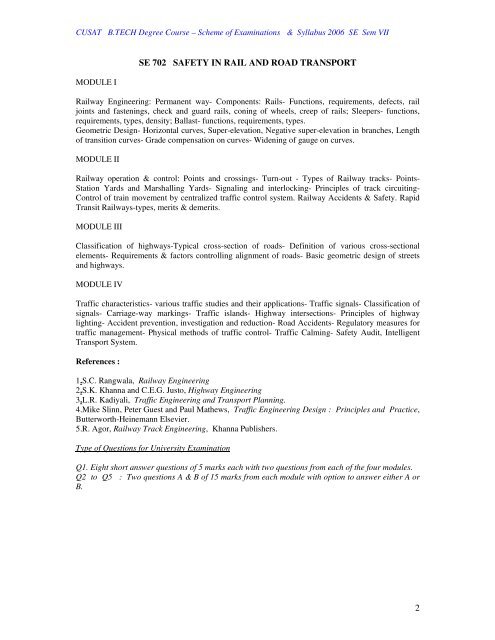se 701 hazard identification and risk assessment - DSpace at CUSAT
se 701 hazard identification and risk assessment - DSpace at CUSAT
se 701 hazard identification and risk assessment - DSpace at CUSAT
You also want an ePaper? Increase the reach of your titles
YUMPU automatically turns print PDFs into web optimized ePapers that Google loves.
<strong>CUSAT</strong> B.TECH Degree Cour<strong>se</strong> – Scheme of Examin<strong>at</strong>ions & Syllabus 2006 SE Sem VII<br />
MODULE I<br />
SE 702 SAFETY IN RAIL AND ROAD TRANSPORT<br />
Railway Engineering: Permanent way- Components: Rails- Functions, requirements, defects, rail<br />
joints <strong>and</strong> fastenings, check <strong>and</strong> guard rails, coning of wheels, creep of rails; Sleepers- functions,<br />
requirements, types, density; Ballast- functions, requirements, types.<br />
Geometric Design- Horizontal curves, Super-elev<strong>at</strong>ion, Neg<strong>at</strong>ive super-elev<strong>at</strong>ion in branches, Length<br />
of transition curves- Grade compens<strong>at</strong>ion on curves- Widening of gauge on curves.<br />
MODULE II<br />
Railway oper<strong>at</strong>ion & control: Points <strong>and</strong> crossings- Turn-out - Types of Railway tracks- Points-<br />
St<strong>at</strong>ion Yards <strong>and</strong> Marshalling Yards- Signaling <strong>and</strong> interlocking- Principles of track circuiting-<br />
Control of train movement by centralized traffic control system. Railway Accidents & Safety. Rapid<br />
Transit Railways-types, merits & demerits.<br />
MODULE III<br />
Classific<strong>at</strong>ion of highways-Typical cross-<strong>se</strong>ction of roads- Definition of various cross-<strong>se</strong>ctional<br />
elements- Requirements & factors controlling alignment of roads- Basic geometric design of streets<br />
<strong>and</strong> highways.<br />
MODULE IV<br />
Traffic characteristics- various traffic studies <strong>and</strong> their applic<strong>at</strong>ions- Traffic signals- Classific<strong>at</strong>ion of<br />
signals- Carriage-way markings- Traffic isl<strong>and</strong>s- Highway inter<strong>se</strong>ctions- Principles of highway<br />
lighting- Accident prevention, investig<strong>at</strong>ion <strong>and</strong> reduction- Road Accidents- Regul<strong>at</strong>ory measures for<br />
traffic management- Physical methods of traffic control- Traffic Calming- Safety Audit, Intelligent<br />
Transport System.<br />
References :<br />
1.S.C. Rangwala, Railway Engineering<br />
2.S.K. Khanna <strong>and</strong> C.E.G. Justo, Highway Engineering<br />
3.L.R. Kadiyali, Traffic Engineering <strong>and</strong> Transport Planning.<br />
4.Mike Slinn, Peter Guest <strong>and</strong> Paul M<strong>at</strong>hews, Traffic Engineering Design : Principles <strong>and</strong> Practice,<br />
Butterworth-Heinemann El<strong>se</strong>vier.<br />
5.R. Agor, Railway Track Engineering, Khanna Publishers.<br />
Type of Questions for University Examin<strong>at</strong>ion<br />
Q1. Eight short answer questions of 5 marks each with two questions from each of the four modules.<br />
Q2 to Q5 : Two questions A & B of 15 marks from each module with option to answer either A or<br />
B.<br />
2
















